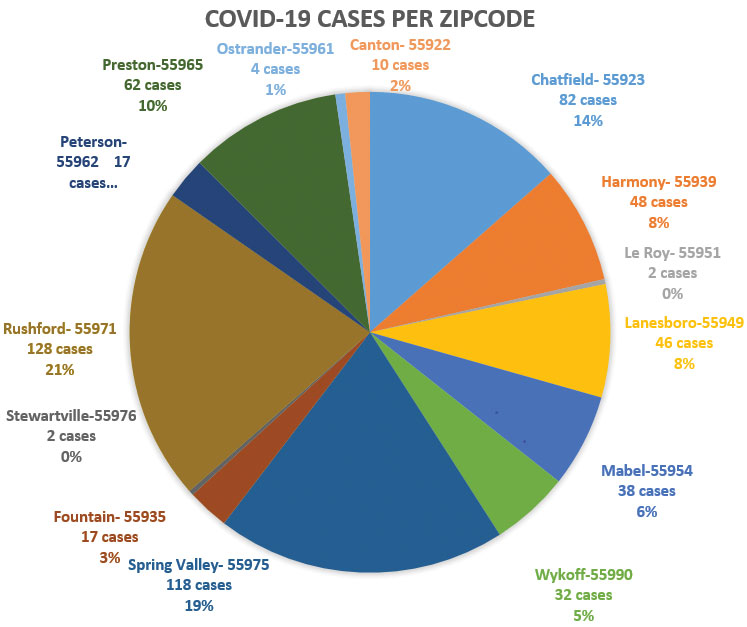The Rushford-Peterson School District notified families of students that they would be moving to full-time distance learning November 7 following an increase in COVID-19 cases within Fillmore County, particularly in Rushford. Now, the district is setting guidelines for determining which learning model to use going forward. The guidelines are flexible, based on a specific set of indicators and will allow the district to “cut” varying portions of its approach if needed.

Image from the Fillmore County website
According to Superintendent Jon Thompson, the “2% Indicator and Scalpel Approach” is gaining traction within both the state and Fillmore County. “This approach allows the district to look at current positive COVID-19 data within our school building and make decisions on learning models while looking at narrow sections of our school population. While county level data will still be utilized, the Scalpel Approach will allow R-P to focus on our own communities and especially our school data,” he noted in the agenda summary.
Currently, deemed by Minnesota Department of Education thresholds, education models may include in-person, hybrid, and distance instruction. A 2% positive COVID case threshold within R-P building levels will effectively trigger a series of reviews within the district to determine if changes are needed within those models. Reviews would be conducted cooperatively with school administration, school nurse Stephanie Evenson, and Fillmore County Health officials, as well as the school board, if needed.
“The scalpel approach allows the district to look at specific groups of students when determining if a learning model change is needed,” continued Thompson’s summary. “This might be as specific as a sports team or a single classroom, or it may be a more widespread change that would involve multiple grade levels or the entire PK-12 district. Again, this would be true for a change to a more restrictive or a less.”
Two percent of the district levels was clarified as one positive case within Pre-K, five in the elementary, and four in both the middle and high school grades. “Once a determination is made the data will be reviewed weekly and the school would allow for a minimum of one week notification of any subsequent model change. This would guarantee each decision would be in place for a minimum of two weeks. Extreme case increases may alter this timeline,” noted the summary.
Positivity rates, based on analysis of the number of cases compared to the number being tested, is a critical part of the equation. “A high positivity rate is concerning, even if the district rate isn’t gaining significantly. It’s trying to balance the two and find a way to work with our community to make everyone safe,” said Thomson. A 5% community positivity rate is being utilized by many districts and will be another indicator for R-P.
Thompson further noted details of a November 23 meeting with Fillmore County Public Health and epidemiologist Jason Zdan, who represents the southeast region for the Minnesota Department of Health. The discussion included what factors to take into account when making instruction changes with the new approach. According to Thompson, research indicates that children age 0-9 are less apt to readily contract and spread COVID-19. “Right from the start, in March, we talked about the importance of getting our youngest learners back in the building,” he said. “We’re really focusing on Pre-K through grade three. The experts gave us pretty clear guidance. Fillmore County should have middle school and high school students in distance learning for the foreseeable future.”
Should data trend in a direction indicating it’s safe to do so, the district hopes to bring students in Pre-K through grade three back into the building in the coming weeks. A decision will be made November 30 about resuming in-person learning for those students on December 8. “I’m about 90% sure. It looks pretty good… I think that’s the right way to say it,” added Thompson.
The district is also utilizing Distance Learning Plus, a method of rotating a select group of students through for work that is hands on or needs special consideration. As of November 23, the district has seven current positive cases: one middle school, four high school, and two that were already distance learning.
“It’s a good plan,” said Board Chairman John Linder. “You really thought this through. We need to be flexible as conditions change for better or worse.”
In other news, the district received a clean audit from Smith Schafer & Associates. At the time of the audit (June 30), revenues were up $26,000. State aid, roughly $8.7 million was also up slightly due to a 2% aid formula increase. Property tax levy makes up 17% of total revenue. The General Fund summary noted a surplus of $182,167 in the current year. Unassigned fund balance, at June 30, was $867,828 or 10.7% of current expenditures. Community Service Fund revenues are down, as in most districts, and efforts are being made to bring the deficit down. Some shifting dollars around will need to occur to align the funds.
A contract with Educational Support Personnel was approved by the board following administration and board subcommittee negotiations. The new contract extends from July 1, 2020 to June 30, 2022. The biggest change noted was an alteration in the payscale, an attempt to move the starting wage up gradually to keep better competitive starting wages. The total increase is 6.57% over three years.
The next regularly scheduled meeting will be held Monday, December 21, at 5:30 p.m. At this time, it’s unclear whether the meeting will be held in person or online. There may be extenuating circumstances for public attendance due to the annual Truth-in-Taxation meeting to be held that evening. A decision on how and where the meeting will be held will be decided and posted in the coming weeks.


Leave a Reply